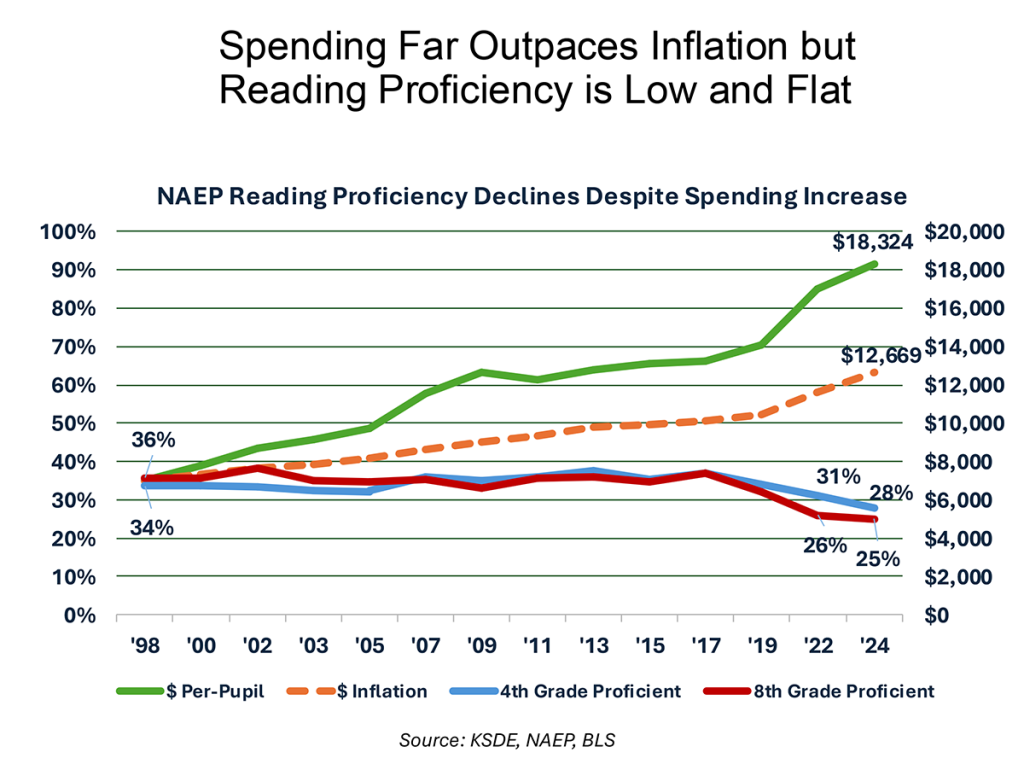Once again NAEP* scores are in the tank. The results of the biennial test of a representative sample of the nation’s 4th and 8th graders in math and reading were released last week. Finally. The most recent scores are from the test administered in the spring of 2024. While most waited for the results with bated breath, those of us who have followed the results since NAEP became mandated as part of the No Child Left Behind law in 2002 know there would be little change from the previous test (2022), and the one before that, and the one before that…
For the record, Kansas now lags behind the nation in proficiency in all eight major categories: 4th and 8th math and reading for both “economically disadvantaged” and “not economically disadvantaged” students. This is the first time Kansas has been able make this infamous claim. An excellent analysis by Kanas Policy Institute CEO Dave Trabert of how and why Kansas has fallen to such depths can be found here.
The results have become quite predictable from test to test. Not enough students are proficient in math and reading. Too many students score “Below Basic” as NAEP categorizes them. The achievement gaps based on both economics and race are sizable and basically stagnant. Oh, all these numbers change a negligible amount from test to test, but it seems that in the big picture of public education, the outcomes have become baked in.

How much more evidence like this is needed for change in the way public schools do business?
In the world of addiction, they say that change in behavior doesn’t happen until one hits rock bottom. Sadly, it’s safe to say that that hasn’t happened yet. Take this quote from one of the country’s top education publications, EdWeek.
“U.S. students’ reading scores have plunged further on the test known as the nation’s report card, while math scores have stagnated for 8th graders and ticked up slightly only for 4th graders—demonstrating that the nation’s children are still struggling to rebound from devastating academic losses supercharged by the pandemic.” (emphasis added)
Yep. This go-around, let’s keep blaming COVID, it worked last time. The 2022 NAEP was the first bite at the COVID apple (without consideration for the unnecessary forced closing of schools). Before that is was the old reliable ‘not enough taxpayer money to public education.’ Before that it was, well, also money. You get the picture.
This unrelenting stagnancy is not unique to NAEP. State assessment scores in Kansas are so low and predictable from year to year that the slightest uptick in change is motif de célébration.
Again, when is enough enough?
The only way student achievement is going to get better, e.g. kids being able to read again, is to change the way the ADULTS behave. How long will those in leadership – legislative, KSDE/SBOE, and district level – allow the education establishment to hang their collective hats on the COVID nail in the name of ‘business as usual?’
Take the science of reading phenomenon. The science of reading has been hailed as the next silver bullet that will surely act as a rising tide that will lift all the literacy boats. Don’t hold your breath. The science of reading has credibility in its approach, but it’s nothing more than a different process and will improve only in the margins. By itself, legislation will not force a change in ADULT behavior. The science of reading or any other curricular change will only help students learn if adults are forced to implement the program by leaders ensuring that statutes are faithfully executed. As I have said repeatedly in this forum, after two decades inside public education, I can say without hesitation that public education is primarily there for the ADULTS, not the kids.
You want to make a difference in the ability of our students to be able to read? There is now a riff off MAGA, known as MAHA (Make America Healthy Again – spurred by the rise of RFK, Jr.). Perhaps the new Secretary of Education, Linda McMahon, should launch a MALA initiative (Make America Literate Again) by putting some teeth into the current federal education law – the Every Student Succeeds Act (ESSA) – by holding states accountable for achievement targets. I’m not joking.
To do that, it takes leadership. Leadership does not fear potential political consequences. True leadership is not a function of how it affects political careers. Leadership in Kansas is loathe to change the way the education establishment does business.
While the rest of the so-called “red” states have been busy instituting school choice (Tennessee, just last week, has become the latest), the fecklessness of elected leadership in this state continues to look the other way regarding giving parents options in their children’s education.
Examples? Kansas is recognized as having the worst charter school law in the country to the point that referring to them as charter schools is a fraud. The term ESA – now the fastest rising form of school choice in the country – is a four-letter word at the state capitol. The decade-old tax credit scholarship program, one that serves barely a thousand students across the state, fights for its life nearly every legislative session. And all this with the background given by the U.S. Supreme Court that the ‘Blaine amendments’ that pollute so many state constitutions – Kansas included – are unconstitutional. What other tailwind is needed?
To the educational leadership in the state, what are you going to do about it?
One more time, when is enough enough?
*NAEP stands for the National Assessment of Educational Progress. Administered by the federal Department of Education. It has been called the “gold standard,” with “valid results” from KSDE, and is provided to a statistically representative sample from each state. It is essentially the only way to track how students from one state compare to their peers from around the country.





